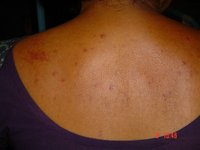Definition
Allergic purpura (AP) is an allergic reaction of unknown origin causing red patches on the skin and other symptoms. AP is also called Henoch-Schonlein purpura, named after the two doctors who first described it.
Description
"Purpura" is a bleeding disorder that occurs when capillaries rupture, allowing small amounts of blood to accumulate in the surrounding tissues. In AP, this occurs because the capillaries are blocked by protein complexes formed during an abnormal immune reaction. The skin is the most obvious site of reaction, but the joints, gastrointestinal tract, and kidneys are also often affected.
AP affects approximately 35,000 people in the United States each year. Most cases are children between the ages of two and seven. Boys are affected more often than girls, and most cases occur from late fall to winter.
Causes & symptoms
Causes
AP is caused by a reaction involving antibodies, special proteins of the immune system. Antibodies are designed to bind with foreign proteins, called antigens. In some situations, antigen-antibody complexes can become too large to remain suspended in the bloodstream. When this occurs, they precipitate out and become lodged in the capillaries. This can cause the capillary to burst, allowing a local hemorrhage.
The source of the antigen causing AP is unknown. Antigens may be introduced by bacterial or viral infection. More than 75% of patients report having had an infection of the throat, upper respiratory tract, or gastrointestinal system several weeks before the onset of AP. Other complex molecules can act as antigens as well, including drugs such as antibiotics or vaccines. Otherwise harmless substances that stimulate an immune reaction are known as allergens. Drug allergens that may cause AP include penicillin, ampicillin, erythromycin, and quinine. Vaccines possibly linked to AP include those for typhoid, measles, cholera, and yellow fever.
Symptoms
The onset of AP may be preceded by a headache, fever, and loss of appetite. Most patients first develop an itchy skin rash. The rash is red, either flat or raised, and may be small and freckle-like. The rash may also be larger, resembling a bruise. Rashes become purple and then rust colored over the course of a day, and fade after several weeks. Rashes are most common on the buttocks, abdomen, and lower extremities. Rashes higher on the body may also occur, especially in younger children.
Joint pain and swelling is common, especially in the knees and ankles. Abdominal pain occurs in almost all patients, along with blood in the body waste (feces). About half of all patients show blood in the urine, low urine volume, or other signs of kidney involvement. Kidney failure may occur due to widespread obstruction of the capillaries in the filtering structures called glomeruli. Kidney failure develops in about 5% of all patients, and in 15% of those with elevated blood or protein in the urine.
Less common symptoms include prolonged headache, fever, and pain and swelling of the scrotum. Involvement of other organ systems may lead to heart attack (myocardial infarction), inflammation of the pancreas (pancreatitis), intestinal obstruction, or bowel perforation.
Diagnosis
Diagnosis of AP is based on the symptoms and their development, a careful medical history, and blood and urine tests. X rays or computed tomography scans (CT) may be performed to assess complications in the bowel or other internal organs.
Treatment
Most cases of AP resolve completely without treatment. Nonetheless, a hospital stay is required because of the possibility of serious complications. Non-aspirin pain relievers may be given for joint pain. Corticosteroids (like prednisone) are sometimes used, although not all specialists agree on their utility. Kidney involvement requires monitoring and correction of blood fluids and electrolytes.
Patients with severe kidney complications may require a kidney biopsy so that tissue can be analyzed. Even after all other symptoms subside, elevated levels of blood or protein in the urine may persist for months and require regular monitoring. Hypertension or kidney failure may develop months or even years after the acute phase of the disease. Kidney failure requires dialysis or transplantation.
Plasmapheresis, which removes antibodies from the blood, has been tried for AP with mixed results.
Prognosis
Most people who develop AP become better on their own after several weeks. About half of all patients have at least one recurrence. Cases that do not have kidney complications usually have the best prognosis.
Key Terms
- Glomeruli
- Knots of capillaries in the kidneys responsible for filtering the blood (singular, glomerulus).
Further Reading
For Your Information
Periodicals
- Andreoli, S. P. "Chronic glomerulonephritis in childhood. Membranoproliferative glomerulonephritis, Henoch-Schonlein purpura nephritis, and IgA nephropathy." Pediatric Clinics of North America, 42 (6)(December 1995): 1487-1503.
Other
- Dyne, Pamela. Pediatrics, Henoch-Schonlein Purpura. http://www.emedicine.com/emerg/.
- Henoch-Schonlein Purpura. http://www.mc.vanderbilt.edu/peds/pidl/nephro/henoch.html.
Gale Encyclopedia of Medicine. Gale Research, 1999.



